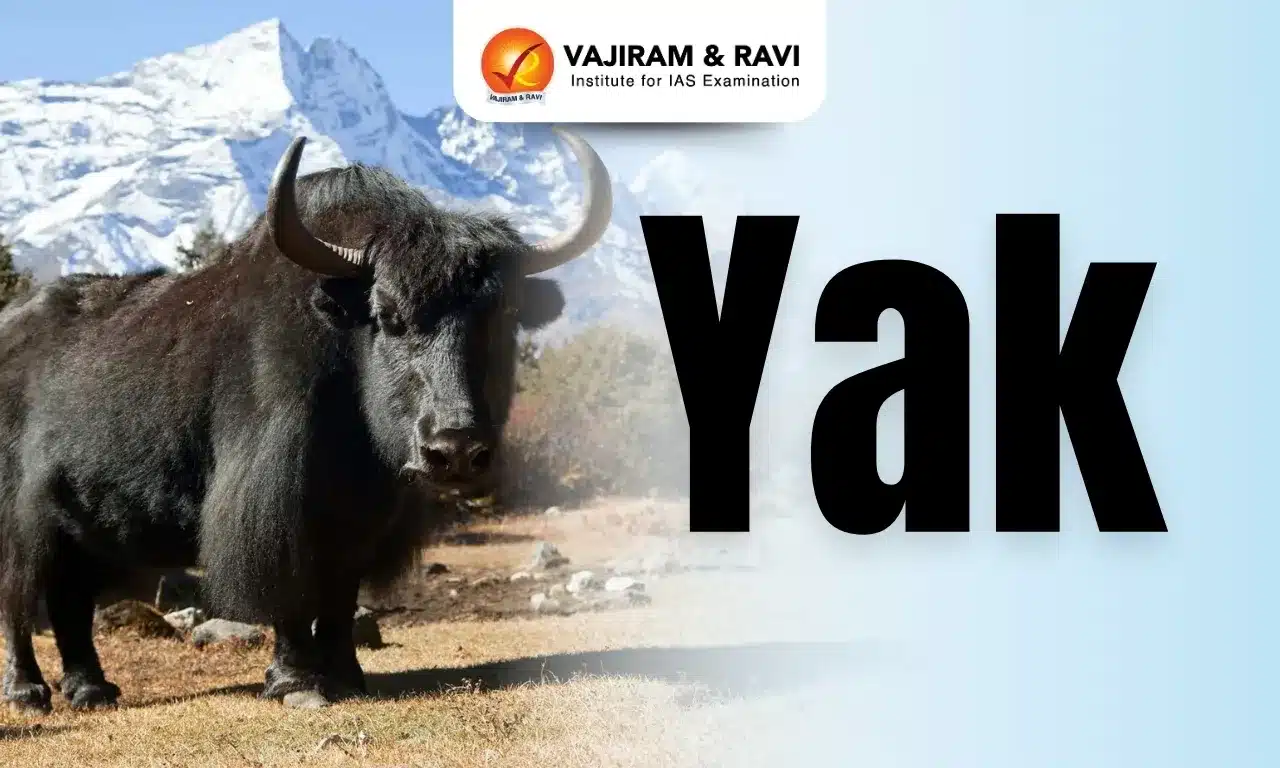Yak Latest News
Nepal observed its first-ever ‘National Yak Day’ on April 20, 2025, to honor the cultural, ecological, and economic value of the yak in the Himalayan region.
Why in the News?
- The International Centre for Integrated Mountain Development (ICIMOD) urged stakeholders to elevate the yak to its rightful place in the sustainable development agenda, especially across the Hindu Kush Himalaya (HKH) region.
- ICIMOD emphasised that indigenous communities like the Sherpa, Tamang, Thakali, Rai, and Limbu have historically protected and practiced yak herding, linking it with food security, cultural identity, and biodiversity conservation.
Biological and Geographic Features of Yak
- Scientific Name:Wild yak: Bos mutus; Domesticated yak: Bos grunniens
- Habitat: Wild yaks inhabit alpine tundra at altitudes of 5000 to 7000 meters. They thrive in environments such as alpine meadows, alpine steppes, and desert steppes.
- Geographic distribution: Found throughout the Himalayan region, Tibetan plateau, Mongolia, and parts of South-Central Asia.
- In India, yaks are reared in Arunachal Pradesh, Sikkim, Himachal Pradesh, Uttar Pradesh, and the union territories of Jammu & Kashmir and Ladakh.
Physical Characteristics of Yak
- Wild yaks are around 2 meters tall at the shoulder, while domesticated yaks are smaller.
- They have long, shaggy hair for insulation and curved horns, with larger horns in males.
- Their lung capacity is nearly three times that of cattle, with smaller red blood cells, making them highly adapted to high-altitude, low-oxygen environments.
- Yaks are herbivorous, feeding on grasses and alpine plants.
- Uses and Socio-Economic Importance:
- Domesticated yaks are used for milk, meat, and as pack animals, transporting goods across mountain passes.
- They are also used in climbing and trekking expeditions, capable of ascending up to 20,000 feet.
- Yaks are often crossbred with domestic cattle to produce dzo or chauri gai, which are adaptable hybrids used in agropastoralism across altitudinal gradients.
- Conservation Status: Wild yaks are listed as ‘Vulnerable’ on the IUCN Red List, indicating the need for urgent conservation efforts to protect their habitats and genetic diversity.
Source: DTE
Last updated on December, 2025
→ Check out the latest UPSC Syllabus 2026 here.
→ Join Vajiram & Ravi’s Interview Guidance Programme for expert help to crack your final UPSC stage.
→ UPSC Mains Result 2025 is now out.
→ UPSC Notification 2026 is scheduled to be released on January 14, 2026.
→ UPSC Calendar 2026 is released on 15th May, 2025.
→ The UPSC Vacancy 2025 were released 1129, out of which 979 were for UPSC CSE and remaining 150 are for UPSC IFoS.
→ UPSC Prelims 2026 will be conducted on 24th May, 2026 & UPSC Mains 2026 will be conducted on 21st August 2026.
→ The UPSC Selection Process is of 3 stages-Prelims, Mains and Interview.
→ UPSC Result 2024 is released with latest UPSC Marksheet 2024. Check Now!
→ UPSC Prelims Result 2025 is out now for the CSE held on 25 May 2025.
→ UPSC Toppers List 2024 is released now. Shakti Dubey is UPSC AIR 1 2024 Topper.
→ UPSC Prelims Question Paper 2025 and Unofficial Prelims Answer Key 2025 are available now.
→ UPSC Mains Question Paper 2025 is out for Essay, GS 1, 2, 3 & GS 4.
→ UPSC Mains Indian Language Question Paper 2025 is now out.
→ UPSC Mains Optional Question Paper 2025 is now out.
→ Also check Best IAS Coaching in Delhi
Yak FAQs
Q1. What is a Yak?+
Q2. In which Indian states are Yaks commonly reared?+
Q3. Why are Yaks important for high-altitude economies?+

















